Hyundai Ioniq Hybrid 2020 Owner's Manual - RHD (UK, Australia)
Manufacturer: HYUNDAI, Model Year: 2020, Model line: Ioniq Hybrid, Model: Hyundai Ioniq Hybrid 2020Pages: 613, PDF Size: 58.64 MB
Page 191 of 613
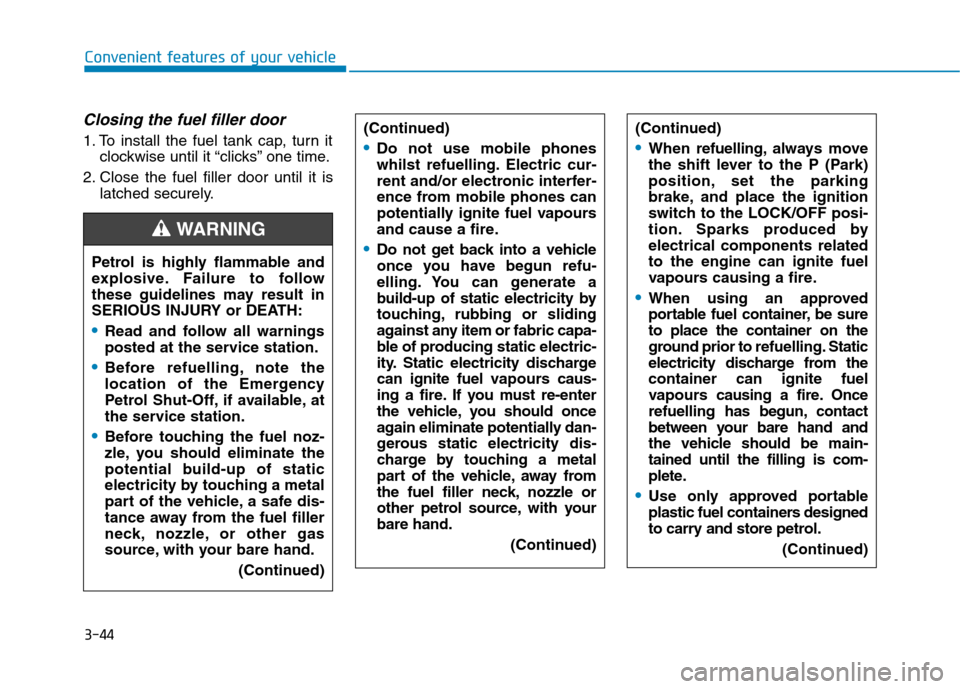
3-44
Closing the fuel filler door
1. To install the fuel tank cap, turn it
clockwise until it “clicks” one time.
2. Close the fuel filler door until it is
latched securely.
Convenient features of your vehicle
Petrol is highly flammable and
explosive. Failure to follow
these guidelines may result in
SERIOUS INJURY or DEATH:
Read and follow all warnings
posted at the service station.
Before refuelling, note the
location of the Emergency
Petrol Shut-Off, if available, at
the service station.
Before touching the fuel noz-
zle, you should eliminate the
potential build-up of static
electricity by touching a metal
part of the vehicle, a safe dis-
tance away from the fuel filler
neck, nozzle, or other gas
source, with your bare hand.
(Continued)
WARNING
(Continued)
Do not use mobile phones
whilst refuelling. Electric cur-
rent and/or electronic interfer-
ence from mobile phones can
potentially ignite fuel vapours
and cause a fire.
Do not get back into a vehicle
once you have begun refu-
elling. You can generate a
build-up of static electricity by
touching, rubbing or sliding
against any item or fabric capa-
ble of producing static electric-
ity. Static electricity discharge
can ignite fuel vapourscaus-
ing a fire. If you must re-enter
the vehicle, you should once
again eliminate potentially dan-
gerous static electricity dis-
charge by touching a metal
part of the vehicle, away from
the fuel filler neck, nozzle or
other petrol source, with your
bare hand.
(Continued)
(Continued)
When refuelling, always move
the shift lever to the P (Park)
position, set the parking
brake, and place the ignition
switch to the LOCK/OFF posi-
tion. Sparks produced by
electrical components related
to the engine can ignite fuel
vapours causing a fire.
When using an approved
portable fuel container, be sure
to place the container on the
ground prior to refuelling.Static
electricity discharge from the
container can ignite fuel
vapourscausing a fire. Once
refuelling has begun, contact
between your bare hand and
the vehicle should be main-
tained until the filling is com-
plete.
Use only approved portable
plastic fuel containers designed
to carry and store petrol.
(Continued)
Page 192 of 613
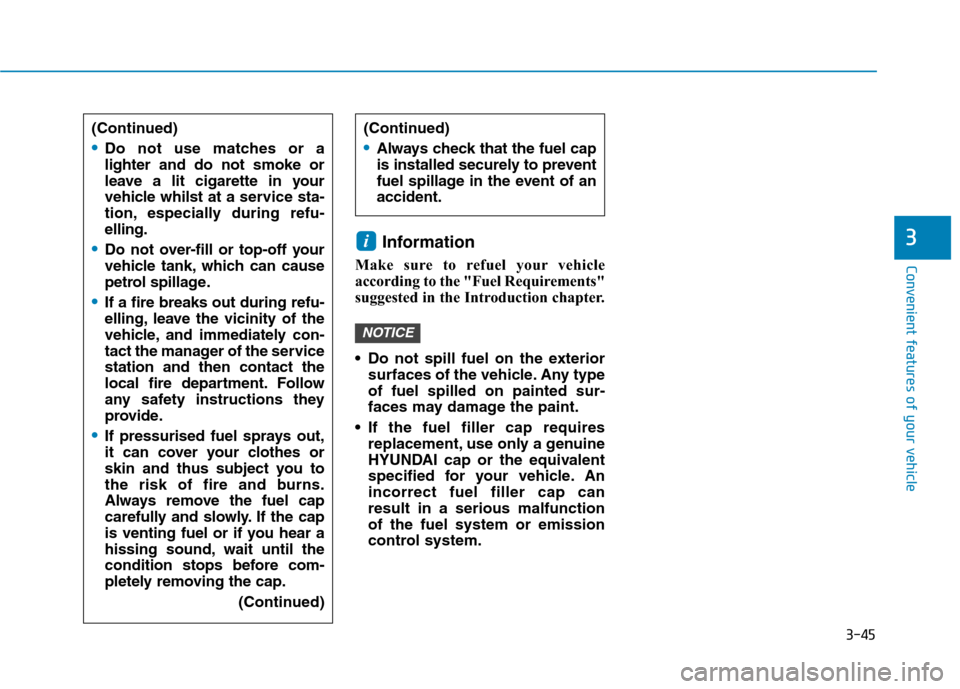
3-45
Convenient features of your vehicle
Information
Make sure to refuel your vehicle
according to the "Fuel Requirements"
suggested in the Introduction chapter.
Do not spill fuel on the exterior
surfaces of the vehicle. Any type
of fuel spilled on painted sur-
faces may damage the paint.
If the fuel filler cap requires
replacement, use only a genuine
HYUNDAI cap or the equivalent
specified for your vehicle. An
incorrect fuel filler cap can
result in a serious malfunction
of the fuel system or emission
control system.
NOTICE
i3
(Continued)
Do not use matches or a
lighter and do not smoke or
leave a lit cigarette in your
vehicle whilst at a service sta-
tion, especially during refu-
elling.
Do not over-fill or top-off your
vehicle tank, which can cause
petrol spillage.
If a fire breaks out during refu-
elling, leave the vicinity of the
vehicle, and immediately con-
tact the manager of the service
station and then contact the
local fire department. Follow
any safety instructions they
provide.
If pressurised fuel sprays out,
it can cover your clothes or
skin and thus subject you to
the risk of fire and burns.
Always remove the fuel cap
carefully and slowly. If the cap
is venting fuel or if you hear a
hissing sound, wait until the
condition stops before com-
pletely removing the cap.
(Continued)
(Continued)
Always check that the fuel cap
is installed securely to prevent
fuel spillage in the event of an
accident.
Page 193 of 613
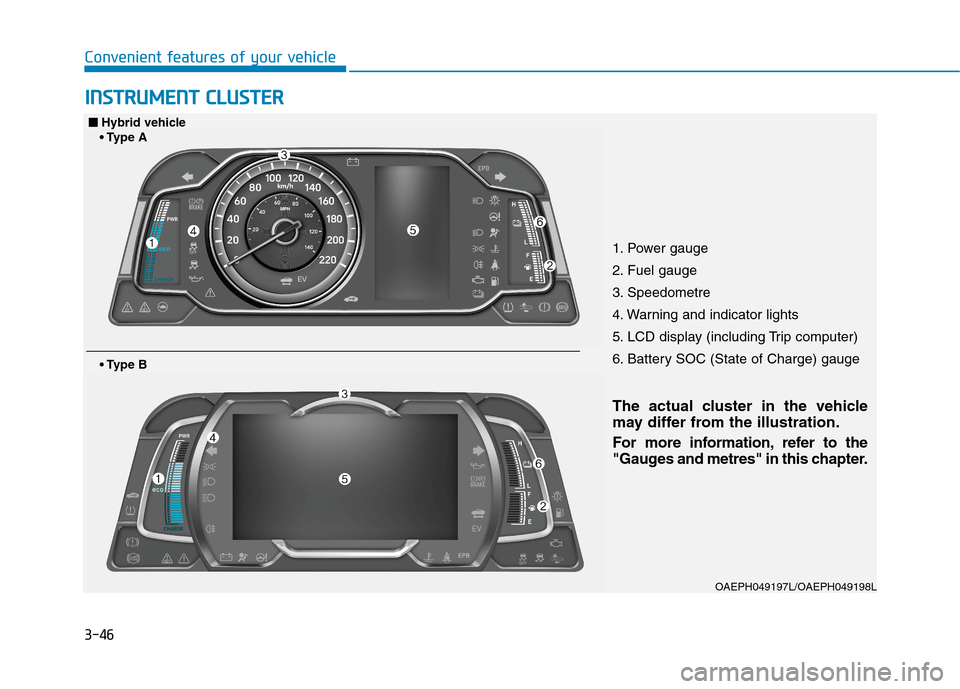
3-46
I IN
NS
ST
TR
RU
UM
ME
EN
NT
T
C
CL
LU
US
ST
TE
ER
R
Convenient features of your vehicle
1. Power gauge
2. Fuel gauge
3. Speedometre
4. Warning and indicator lights
5. LCD display (including Trip computer)
6. Battery SOC (State of Charge) gauge
OAEPH049197L/OAEPH049198L
B ■ ■
Hybrid vehicle
A
The actual cluster in the vehicle
may differ from the illustration.
For more information, refer to the
"Gauges and metres" in this chapter.
Page 194 of 613
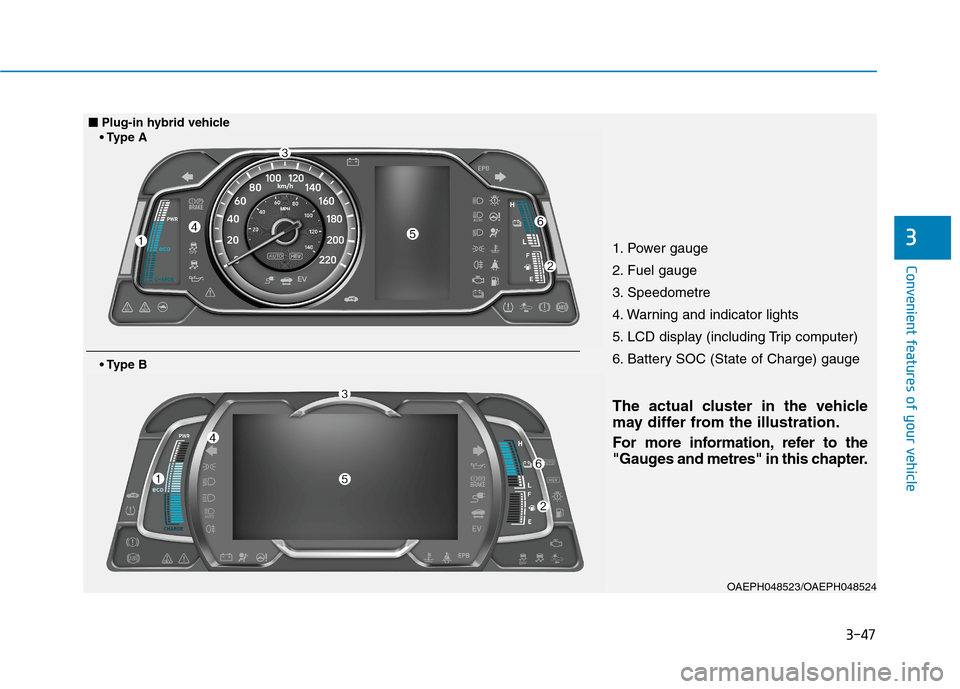
3-47
Convenient features of your vehicle
31. Power gauge
2. Fuel gauge
3. Speedometre
4. Warning and indicator lights
5. LCD display (including Trip computer)
6. Battery SOC (State of Charge) gauge
OAEPH048523/OAEPH048524
B ■ ■
Plug-in hybrid vehicle
A
The actual cluster in the vehicle
may differ from the illustration.
For more information, refer to the
"Gauges and metres" in this chapter.
Page 195 of 613
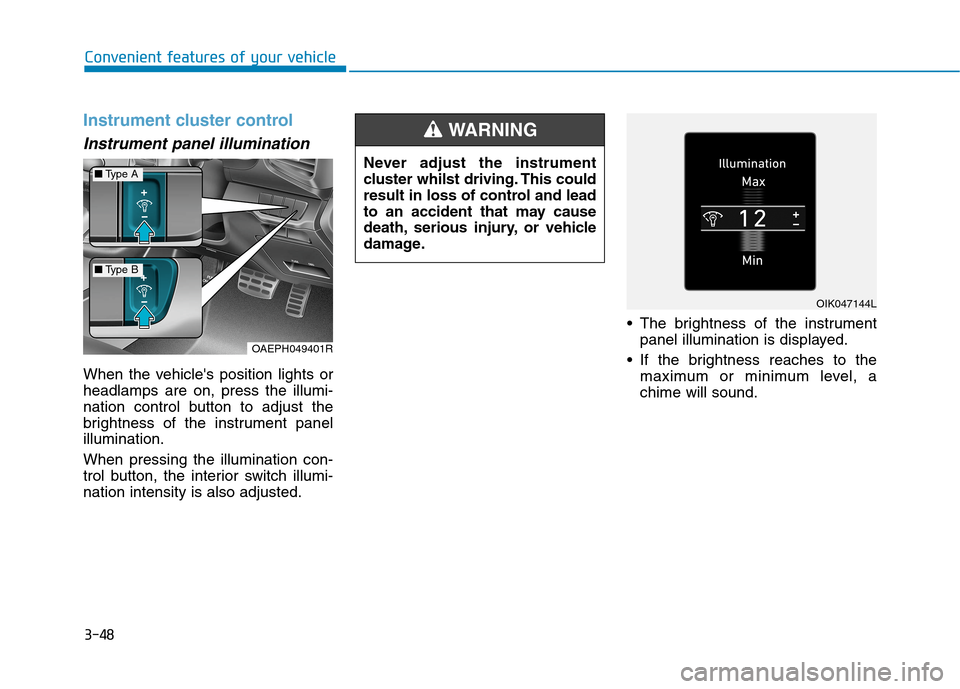
3-48
Convenient features of your vehicle
Instrument cluster control
Instrument panel illumination
When the vehicle's position lights or
headlamps are on, press the illumi-
nation control button to adjust the
brightness of the instrument panel
illumination.
When pressing the illumination con-
trol button, the interior switch illumi-
nation intensity is also adjusted. The brightness of the instrument
panel illumination is displayed.
If the brightness reaches to the
maximum or minimum level, a
chime will sound. Never adjust the instrument
cluster whilst driving. This could
result in loss of control and lead
to an accident that may cause
death, serious injury, or vehicle
damage.
WARNING
OAEPH049401R
■Type A
■Type B
OIK047144L
Page 196 of 613
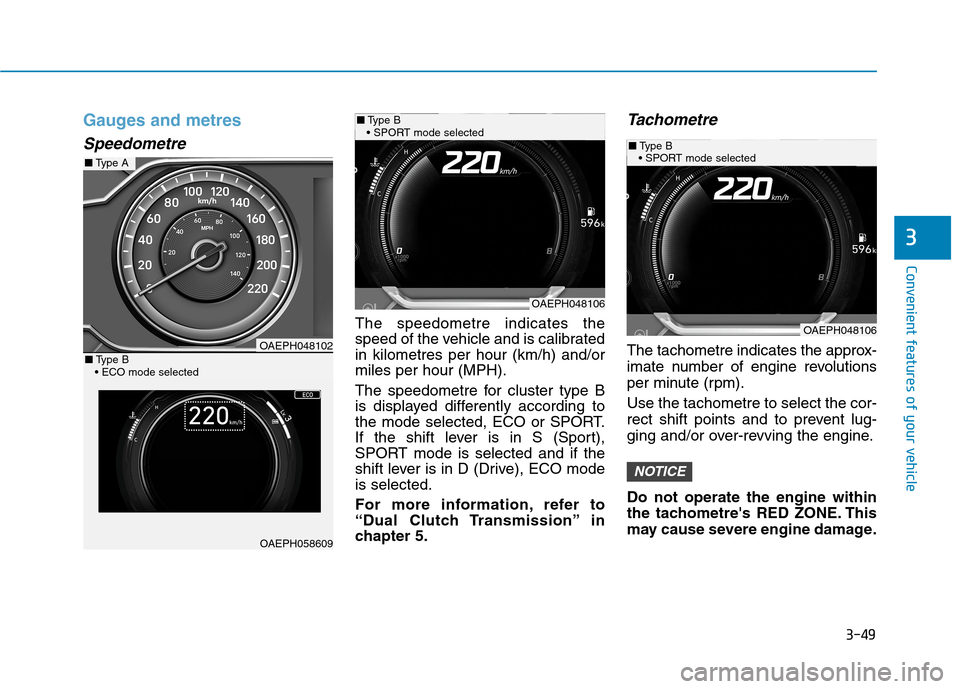
3-49
Convenient features of your vehicle
3
Gauges and metres
Speedometre
The speedometre indicates the
speed of the vehicle and is calibrated
in kilometres per hour (km/h) and/or
miles per hour (MPH).
The speedometre for cluster type B
is displayed differently according to
the mode selected, ECO or SPORT.
If the shift lever is in S (Sport),
SPORT mode is selected and if the
shift lever is in D (Drive), ECO mode
is selected.
For more information, refer to
“Dual Clutch Transmission” in
chapter 5.
Tachometre
The tachometre indicates the approx-
imate number of engine revolutions
per minute (rpm).
Use the tachometre to select the cor-
rect shift points and to prevent lug-
ging and/or over-revving the engine.
Do not operate the engine within
the tachometre's RED ZONE. This
may cause severe engine damage.
NOTICE
OAEPH048102
OAEPH058609
■Type A
■Type B
OAEPH048106
■Type B
OAEPH048106
■Type B
Page 197 of 613
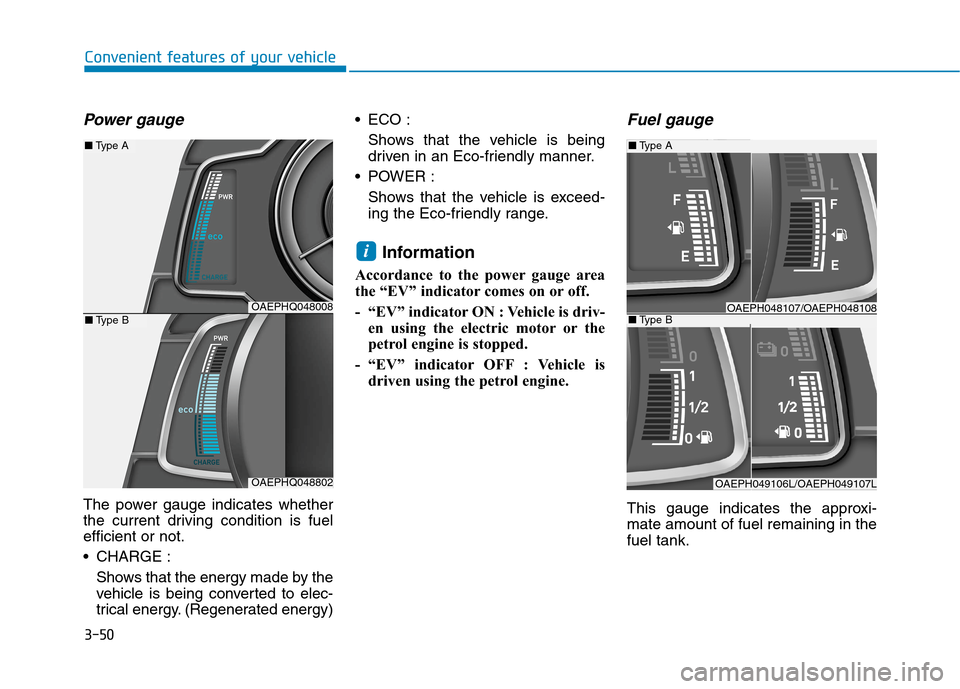
3-50
Convenient features of your vehicle
Power gauge
The power gauge indicates whether
the current driving condition is fuel
efficient or not.
CHARGE :
Shows that the energy made by the
vehicle is being converted to elec-
trical energy. (Regenerated energy) ECO :
Shows that the vehicle is being
driven in an Eco-friendly manner.
POWER :
Shows that the vehicle is exceed-
ing the Eco-friendly range.
Information
Accordance to the power gauge area
the “EV” indicator comes on or off.
- “EV” indicator ON : Vehicle is driv-
en using the electric motor or the
petrol engine is stopped.
- “EV” indicator OFF : Vehicle is
driven using the petrol engine.
Fuel gauge
This gauge indicates the approxi-
mate amount of fuel remaining in the
fuel tank.
i
■Type A
■Type B
OAEPH049106L/OAEPH049107L
OAEPH048107/OAEPH048108OAEPHQ048008
OAEPHQ048802
■Type A
■Type B
Page 198 of 613
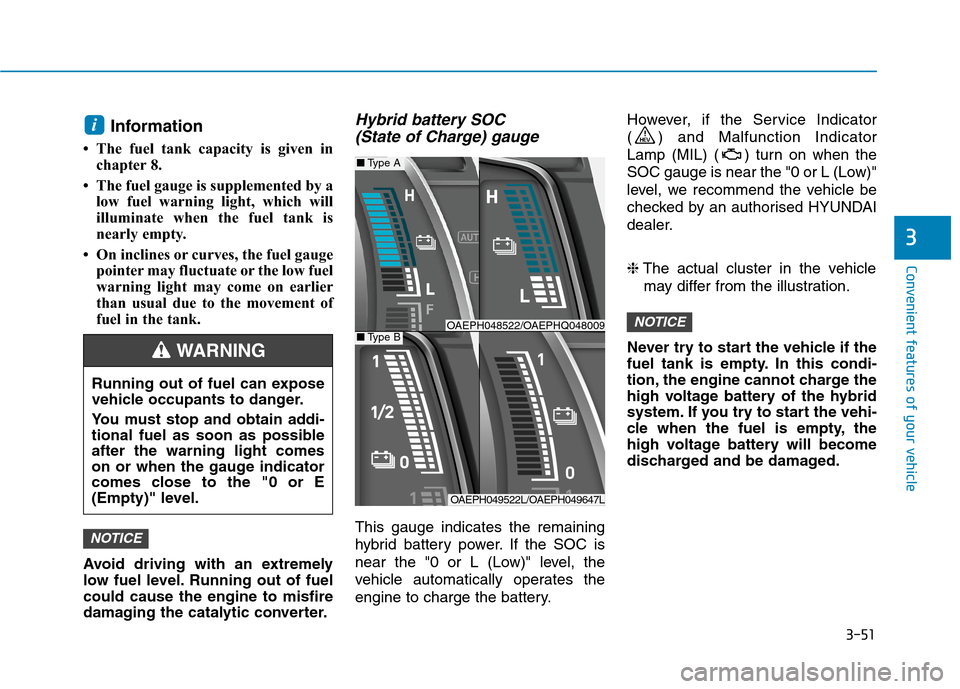
3-51
Convenient features of your vehicle
3
Information
• The fuel tank capacity is given in
chapter 8.
• The fuel gauge is supplemented by a
low fuel warning light, which will
illuminate when the fuel tank is
nearly empty.
• On inclines or curves, the fuel gauge
pointer may fluctuate or the low fuel
warning light may come on earlier
than usual due to the movement of
fuel in the tank.
Avoid driving with an extremely
low fuel level. Running out of fuel
could cause the engine to misfire
damaging the catalytic converter.
Hybrid battery SOC
(State of Charge) gauge
This gauge indicates the remaining
hybrid battery power. If the SOC is
near the "0 or L (Low)" level, the
vehicle automatically operates the
engine to charge the battery.However, if the Service Indicator
( ) and Malfunction Indicator
Lamp (MIL) ( ) turn on when the
SOC gauge is near the "0 or L (Low)"
level, we recommend the vehicle be
checked by an authorised HYUNDAI
dealer.
❈The actual cluster in the vehicle
may differ from the illustration.
Never try to start the vehicle if the
fuel tank is empty. In this condi-
tion, the engine cannot charge the
high voltage battery of the hybrid
system. If you try to start the vehi-
cle when the fuel is empty, the
high voltage battery will become
discharged and be damaged.
NOTICE
NOTICE
i
Running out of fuel can expose
vehicle occupants to danger.
You must stop and obtain addi-
tional fuel as soon as possible
after the warning light comes
on or when the gauge indicator
comes close to the "0 or E
(Empty)" level.
WARNING
■Type A
■Type BOAEPH048522/OAEPHQ048009
OAEPH049522L/OAEPH049647L
Page 199 of 613
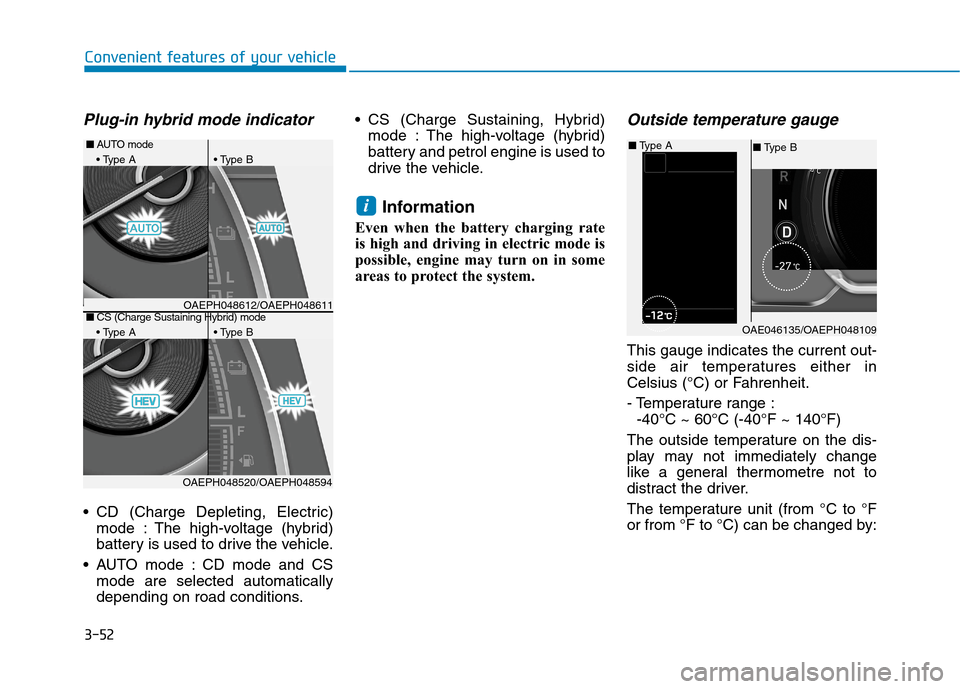
3-52
Convenient features of your vehicle
Plug-in hybrid mode indicator
CD (Charge Depleting, Electric)
mode : The high-voltage (hybrid)
battery is used to drive the vehicle.
AUTO mode : CD mode and CS
mode are selected automatically
depending on road conditions. CS (Charge Sustaining, Hybrid)
mode : The high-voltage (hybrid)
battery and petrol engine is used to
drive the vehicle.
Information
Even when the battery charging rate
is high and driving in electric mode is
possible, engine may turn on in some
areas to protect the system.
Outside temperature gauge
This gauge indicates the current out-
side air temperatures either in
Celsius (°C) or Fahrenheit.
- Temperature range :
-40°C ~ 60°C (-40°F ~ 140°F)
The outside temperature on the dis-
play may not immediately change
like a general thermometre not to
distract the driver.
The temperature unit (from °C to °F
or from °F to °C) can be changed by:
i
OAE046135/OAEPH048109
■Type B ■Type A■AUTO mode
A B
OAEPH048520/OAEPH048594
■CS (Charge Sustaining Hybrid) mode
A BOAEPH048612/OAEPH048611
Page 200 of 613
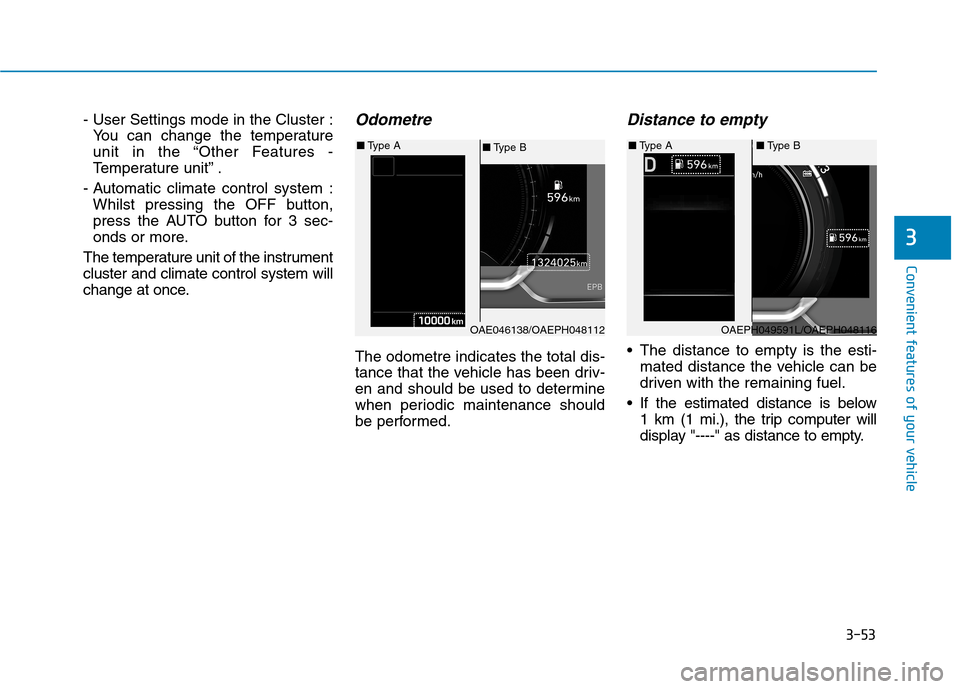
3-53
Convenient features of your vehicle
3
- User Settings mode in the Cluster :
You can change the temperature
unit in the “Other Features -
Temperature unit” .
- Automatic climate control system :
Whilst pressing the OFF button,
press the AUTO button for 3 sec-
onds or more.
The temperature unit of the instrument
cluster and climate control system will
change at once.Odometre
The odometre indicates the total dis-
tance that the vehicle has been driv-
en and should be used to determine
when periodic maintenance should
be performed.
Distance to empty
The distance to empty is the esti-
mated distance the vehicle can be
driven with the remaining fuel.
If the estimated distance is below
1 km (1 mi.), the trip computer will
display "----" as distance to empty.
OAE046138/OAEPH048112
■Type B ■Type A
OAEPH049591L/OAEPH048116
■Type A■Type B